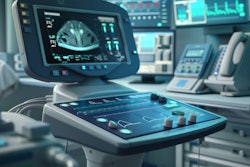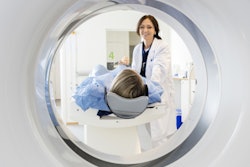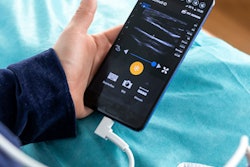Ultrasound's portability, reliability, sustainability, and versatility will be highlighted at this year's ECR, emphasizing its added value in a wide variety of clinical applications.
Research to be presented in Vienna will investigate the modality's use in abdominal, genitourinary, musculoskeletal, women's imaging, and other areas. This includes the use of contrast for improved imaging, elastography, and color Doppler for assessing complex pathologies and using imaging data in AI models.
Studies will also evaluate ultrasound's performance compared with CT and MRI in detecting pathologies, as well as how ultrasonic measures validate treatment strategies like radiotherapy in cancer treatment and surgery for musculoskeletal pathologies. Research will show how using sonographic imaging data in machine learning can improve current risk assessment models. Contrast-enhanced ultrasound techniques will also come under scrutiny.
Below is a round-up of the ECR 2025 ultrasound sessions that captured our attention. Also, market analyst Mustafa Hassan, PhD, writes about what to expect at the congress.
Abdominal
In abdominal ultrasound, the focus will be on optimization of hepatic examinations, patient follow-up after interventional procedures, use of AI and machine learning, and other hot topics. These are our highlighted sessions:
- Hepatic steatosis, fibrosis and siderosis: How to quantify and how to report? RC 601: 26 February, 16:30-17:30 CET, ACV Room M3
- Estimation of liver fat and stiffness with imaging. RPS 401: 26 February, 13:00-14:30 CET, ACV Research Stage 4
- Advanced liver ultrasound: shear wave elastography and fat quantification, techniques and interpretation. HW 5Ub: 26 February, 15:00-16:30 CET, ACV WS1
- Radiologic advances in hepatobiliary and pancreatic cancer. RPS 1016: 27 February, 14:00-15:30 CET, ACV Research Stage 4
- Shining a spotlight on HCC and liver transplant. RPS 2001: 1 March, 14:00-15:30 CET, ACV Research Stage 4
Emergency/POCUS
In emergency room imaging and point-of-care ultrasound (POCUS), these two sessions caught our eye:
- Radiographer-operated urgent diagnostic imaging in hybrid mobile stroke unit: a pilot technical study in challenging conditions. RPS 314: 26 February, 11:30-12:30 CET, ACV Room G1
- Contrast-enhanced ultrasound for post-traumatic spleen lesion assessment: A radiation-free diagnostic alternative. RPS 1517: 28 February, 14:00-15:30 CET, ACV Research Stage 1
Genitourinary (GU)
The best use of ultrasound imaging in GU patients will be an important theme at ECR 2025. Here is a selection of GU presentations:
- What a radiologist should know: paediatric ultrasound. US 10: 27 February, 14:00-15:30 CET, ACV Room M2
- What a radiologist should know: microperfusion techniques outside the liver (CEUS, Doppler, new techniques). US 13: 28 February, 09:30-11:00 CET, ACV Room M4
- Body imaging in children: from head to toe. RPS 1512: 28 February, 14:00-15:30 CET, ACV Research Stage 3
- Advances in imaging techniques for the genitourinary tract. RPS 1707: 1 March, 08:00-09:00 CET, ACV Research Stage 1
- What's new in genitourinary and female health interventions? RPS 1809: 1 March, 09:30-11:00 CET, ACV Research Stage 1
Musculoskeletal (MSK)
Developments in shear-wave elastography and ultrasound-guided procedures will highlight MSK ultrasound presentations in Vienna.
- Shear wave elastography evaluation of plantar fasciitis after platelet rich plasma injection: A multicenter prospective study. RPS 310: 26 February, 11:30-12:30 CET, ACV Research Stage 4
- Dominance differences in hamstring differences among athletes: Insights from ultrasound shear wave elastography. RPS 310: 26 February, 11:30-12:30 CET, ACV Research Stage 4
- Real-time elastosonography of the Achilles tendon and plantar fascia: Predictive insights for diabetic foot ulcers. RPS 310: 26 February, 11:30-12:30 CET, ACV Research Stage 4
- Evaluation of contrast-enhanced ultrasound for rheumatoid arthritis activity in patients who do not respond to second-line biologic therapy compared with superb microvascular imaging: first results. RPS 810: 27 February, 10:00-11:00 CET, ACV Research Stage 2
- Results of US-guided hyaluronic acid in patients with ankle osteoarthritis and osteochrondal lesions of the talus. RPS 1009: 27 February, 14:00-15:30 CET, ACV Research Stage 3
- Ultrasound-guided navigation system for spine surgery. RPS 2310: 2 March, 09:30- 11:00 CET, ACV Research Stage 1
Women's imaging
At ECR 2025, these sessions captured our interest:
- Artificial intelligence in breast imaging. RPS 705: 27 February, 08:00-09:30 CET, ACV Research Stage 3
- Insights into foetal imaging. RPS 912: 27 February, 12:30-13:30 CET, ACV Research Stage 2
- Exploring the role of artificial intelligence in breast imaging. RPS 1002: 27 February, 14:00-15:30 CET, ACV Research Stage 4
- New perspectives in breast and gynaecological cancer. RPS 1216: 28 February, 08:00-09:00 CET, ACV Research Stage 1
- Breast. E³ 1523: 28 February, 14:00-15:30 CET, ACV Room M3
- How to approach pelvic masses in women? Talk to the team! MS 20: 1 March, 14:00-15:30 CET, ACV Room B
For full details, go to the conference program: connect.myesr.org/ecr-2025/programme.
Ultrasound technology trends
By Mustafa Hassan, PhD, senior market analyst, Signify Research
As we prepare for another trip to Vienna for ECR 2025, we are considering this year's theme of "Planet Radiology." Global sustainability, healthcare equity, and scientific innovation will be the key focus. While ultrasound is relatively energy-efficient compared to other imaging modalities, sustainability efforts in the field have still attracted attention. Notably, there has been an increasing focus in recent years to ensure that systems are built sustainably, for example, from recycled materials. Additionally, the "Imagers Fixing the World" program will highlight efforts to expand ultrasound technology to remote regions, demonstrating the modality's role in advancing global health equity.
Vendors will no doubt attend ECR with this theme in mind. We expect to see the following:
- Canon Medical will continue to focus on education, with its Canon Medical Academy area.
- GE HealthCare will be displaying digital tools, such as its Digital Expert Connect. It is also expected to unveil the Invenia automated breast ultrasound (ABUS) system. Because GE is a dominant vendor in ABUS, the introduction of a new system could have real traction in growing this market.
- Mindray will showcase its Resona A20 ultrasound system, which provides a multiparametric solution for chronic liver disease assessments.
- Samsung is likely to prioritize the RS85 Prestige and V-series systems. It is likely to exhibit its new Hera Z20 system in a private meeting room.
- Siemens Healthineers is expected to display its updated Sequoia 3.5 system, with its novel AI tools. The product features AI Abdomen, which automatically labels and measures organs in milliseconds and includes comprehensive liver assessment tools to quantify tissue stiffness and hepatic steatosis.
Attendees can expect further enhancements in image quality, user-friendly interfaces, and the integration of AI to aid in diagnostics and workflow optimization. Many countries continue to face the strain of an overworked healthcare workforce, so workflow optimization will remain a key trend at ECR. Also, the drive toward more portable and versatile devices is likely to continue, and vendors will have to cater to a wide range of clinical settings.
Here is a selection of the ultrasound systems launched since ECR 2024:
| Company | Product |
|---|---|
| Kosmos 2.2 | |
| MyLab E80 | |
| Voluson Signature 18 | |
| Voluson Signature 20 | |
| Resona A20 | |
| Hera Z20 | |
| Sequoia 3.5 |
With several new systems expected to be unveiled at ECR 2025, the market is slowly returning to regular launches of systems. This follows the disruption caused by the COVID-19 pandemic in 2020-2021 and the component shortage in 2022.
Overall, ECR 2025 promises to be a showcase for significant advancements in the ultrasound market, with a focus on technological innovation, collaborative research, practical education, and contributions to global health. Vendors will build upon the momentum from previous years and look to further address the workflow and workforce challenges currently having an impact on the market. As vendors pitch their new solutions, price will also continue to be a key consideration, with the current economic climate affecting many countries and resulting in downward pressure on pricing.



